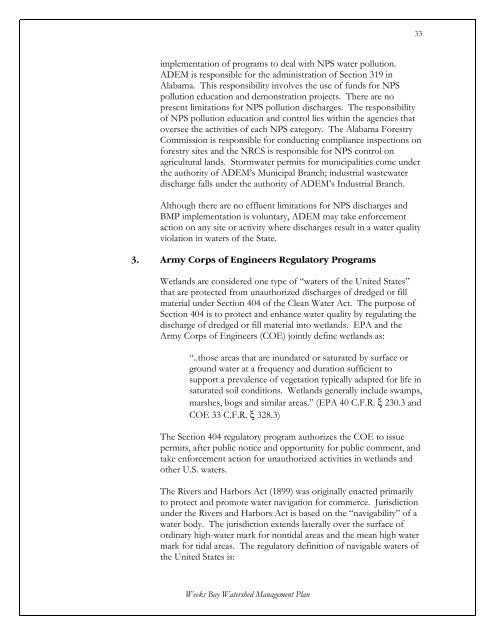Weeks Bay Watershed Project Management Plan - Mobile Bay ...
Weeks Bay Watershed Project Management Plan - Mobile Bay ...
Weeks Bay Watershed Project Management Plan - Mobile Bay ...
You also want an ePaper? Increase the reach of your titles
YUMPU automatically turns print PDFs into web optimized ePapers that Google loves.
33<br />
implementation of programs to deal with NPS water pollution.<br />
ADEM is responsible for the administration of Section 319 in<br />
Alabama. This responsibility involves the use of funds for NPS<br />
pollution education and demonstration projects. There are no<br />
present limitations for NPS pollution discharges. The responsibility<br />
of NPS pollution education and control lies within the agencies that<br />
oversee the activities of each NPS category. The Alabama Forestry<br />
Commission is responsible for conducting compliance inspections on<br />
forestry sites and the NRCS is responsible for NPS control on<br />
agricultural lands. Stormwater permits for municipalities come under<br />
the authority of ADEM’s Municipal Branch; industrial wastewater<br />
discharge falls under the authority of ADEM’s Industrial Branch.<br />
Although there are no effluent limitations for NPS discharges and<br />
BMP implementation is voluntary, ADEM may take enforcement<br />
action on any site or activity where discharges result in a water quality<br />
violation in waters of the State.<br />
3. Army Corps of Engineers Regulatory Programs<br />
Wetlands are considered one type of “waters of the United States”<br />
that are protected from unauthorized discharges of dredged or fill<br />
material under Section 404 of the Clean Water Act. The purpose of<br />
Section 404 is to protect and enhance water quality by regulating the<br />
discharge of dredged or fill material into wetlands. EPA and the<br />
Army Corps of Engineers (COE) jointly define wetlands as:<br />
“..those areas that are inundated or saturated by surface or<br />
ground water at a frequency and duration sufficient to<br />
support a prevalence of vegetation typically adapted for life in<br />
saturated soil conditions. Wetlands generally include swamps,<br />
marshes, bogs and similar areas.” (EPA 40 C.F.R. ξ 230.3 and<br />
COE 33 C.F.R. ξ 328.3)<br />
The Section 404 regulatory program authorizes the COE to issue<br />
permits, after public notice and opportunity for public comment, and<br />
take enforcement action for unauthorized activities in wetlands and<br />
other U.S. waters.<br />
The Rivers and Harbors Act (1899) was originally enacted primarily<br />
to protect and promote water navigation for commerce. Jurisdiction<br />
under the Rivers and Harbors Act is based on the “navigability” of a<br />
water body. The jurisdiction extends laterally over the surface of<br />
ordinary high-water mark for nontidal areas and the mean high water<br />
mark for tidal areas. The regulatory definition of navigable waters of<br />
the United States is:<br />
<strong>Weeks</strong> <strong>Bay</strong> <strong>Watershed</strong> <strong>Management</strong> <strong>Plan</strong>
















